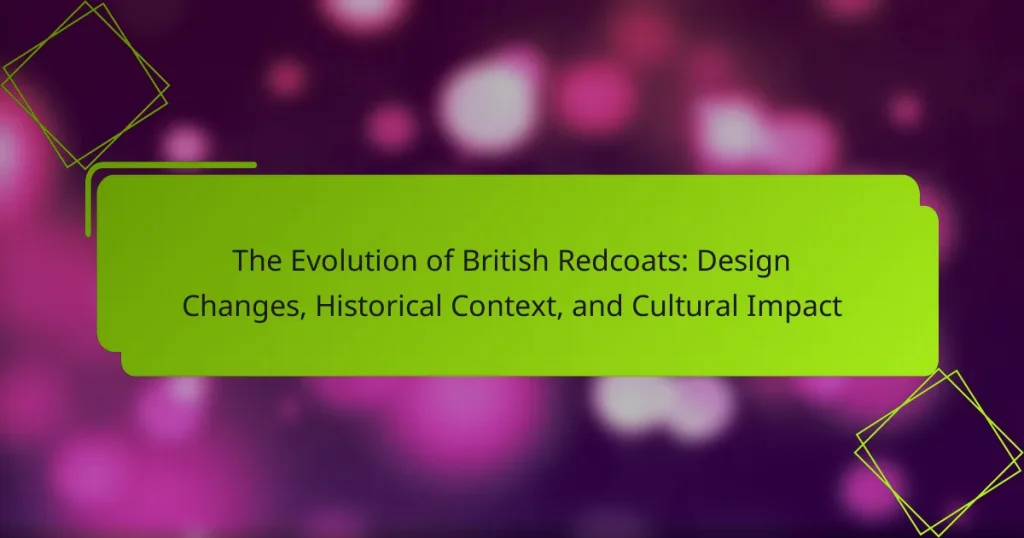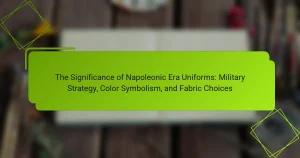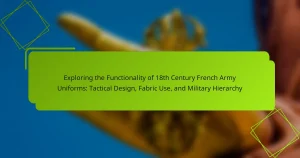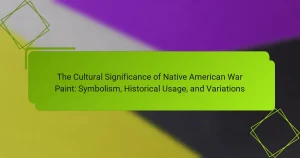British Redcoats were infantry soldiers of the British Army, primarily active from the 17th to the 19th centuries, recognized for their iconic red uniforms designed for battlefield visibility. This article examines the evolution of British Redcoat uniforms, highlighting design changes that reflect adaptations to warfare and climate. It also explores their historical significance in major conflicts, such as the American Revolutionary War, and their cultural impact as symbols of British military identity. Additionally, the article discusses the disciplined formations and tactics of the Redcoats, alongside their representation in literature and media, providing a comprehensive overview of their legacy in British history.
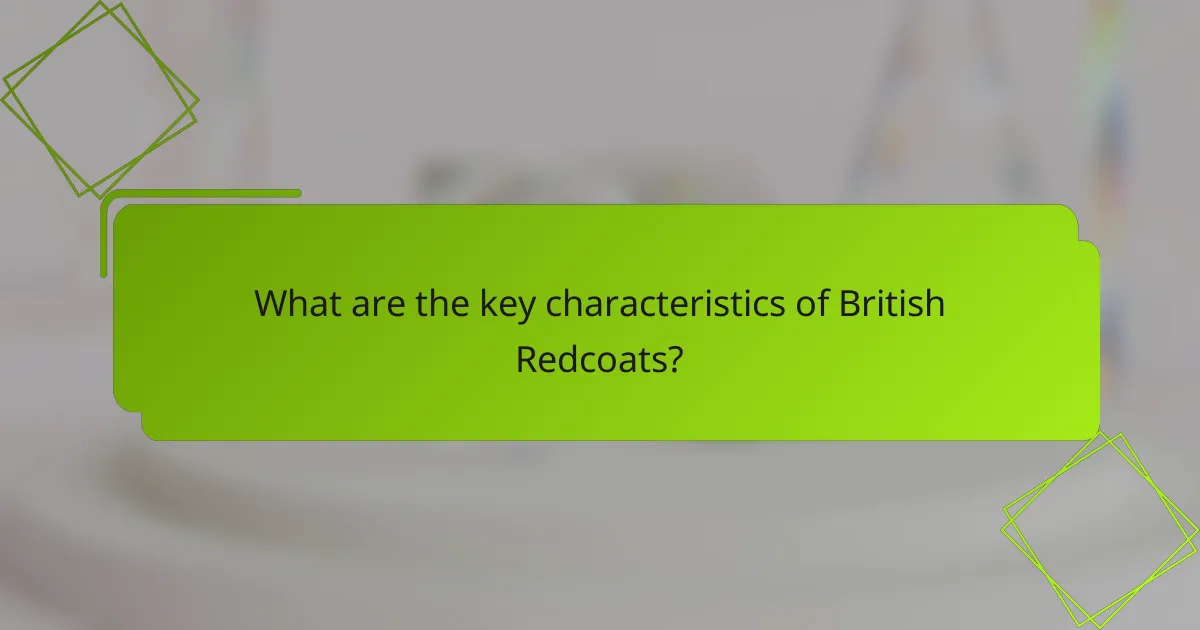
What are the key characteristics of British Redcoats?
British Redcoats are characterized by their distinctive red uniforms, which were designed for visibility on the battlefield. The uniforms typically featured a long coat, often with white or buff facings. They also wore a hat known as a tricorn or a stovepipe hat, depending on the period. The Redcoats were primarily infantry soldiers of the British Army during the 17th to 19th centuries. Their attire was not only functional but also served to symbolize British military power. Additionally, the Redcoats were known for their disciplined formations and tactics, which played a crucial role in various historical conflicts, including the American Revolutionary War.
How did the design of British Redcoats evolve over time?
The design of British Redcoats evolved significantly from the 17th to the 19th centuries. Initially, the Redcoat uniform featured a simple design with a red wool coat and white facings. By the late 18th century, the design included more elaborate details, such as lace and embroidery. The introduction of the “standing collar” in the 1760s marked a major change in military fashion. The cut of the coat also changed, becoming more fitted and tailored to improve mobility.
In the early 19th century, the design further evolved with the adoption of the “shako” hat, replacing earlier headgear. This period also saw the transition to lighter fabrics for better comfort in warmer climates. By the mid-19th century, the Redcoat design incorporated a more practical approach, focusing on functionality while retaining its iconic red color.
These changes reflected broader military reforms and the need for improved soldier performance. The evolution of the British Redcoat design was influenced by both battlefield requirements and contemporary fashion trends.
What were the original design elements of the British Redcoat?
The original design elements of the British Redcoat included a distinctive red wool uniform. This color was chosen for its visibility and psychological impact in battle. The coat featured a long cut, often reaching down to the knees. It typically had a double-breasted front with brass buttons. The uniform also included white or buff-colored facings on the cuffs and collar. Additionally, soldiers wore a black leather belt and a tricorn hat. These elements were standardized in the early 18th century for British infantry regiments. The design aimed to create a sense of unity and discipline among troops.
How did military needs influence design changes in the Redcoat?
Military needs significantly influenced design changes in the Redcoat. The Redcoat was designed for visibility on the battlefield. Bright red fabric helped identify soldiers during combat. However, practicality also played a role in its evolution. The introduction of lighter materials improved mobility. This change was crucial for quick maneuvers in various terrains. Additionally, the need for better protection led to the incorporation of more durable fabrics. Historical records indicate that these adaptations were essential for enhancing soldier performance. The changes reflected the evolving tactics and strategies of warfare.
What historical events shaped the British Redcoat’s evolution?
The British Redcoat’s evolution was shaped by several key historical events. The English Civil War (1642-1651) marked the initial military use of standardized uniforms. The Napoleonic Wars (1803-1815) led to significant changes in military attire for better visibility and identification. The American Revolutionary War (1775-1783) influenced the adoption of more practical designs due to the challenges faced in varied terrains. The introduction of the rifle in the 19th century prompted adaptations for improved functionality. The Crimean War (1853-1856) highlighted the need for durable fabrics and better fit. Each of these events contributed to the Redcoat’s transformation, reflecting changing military strategies and technological advancements.
Which wars or conflicts prominently featured British Redcoats?
The British Redcoats prominently featured in several wars and conflicts, including the American Revolutionary War, the Napoleonic Wars, and the Seven Years’ War. During the American Revolutionary War (1775-1783), Redcoats represented British forces fighting against American colonists. In the Napoleonic Wars (1803-1815), they served as the primary infantry of the British Army against Napoleon’s forces. The Seven Years’ War (1756-1763) also saw Redcoats in action, fighting in various theaters across Europe and North America. These conflicts highlight the significant role of British Redcoats in military history.
How did the role of the British Redcoat change during these events?
The role of the British Redcoat evolved significantly during key historical events. Initially, Redcoats served primarily as infantry soldiers in the British Army. Their primary function was to maintain order and enforce British rule in colonies. As tensions escalated, especially during the American Revolutionary War, their role shifted to one of occupation and suppression. They became symbols of British authority, facing increasing resistance from colonists. The perception of Redcoats changed as they were viewed less as protectors and more as oppressors. This transformation influenced military strategies and public sentiment. Ultimately, the Redcoat’s role reflected broader changes in British colonial policy and military engagement.
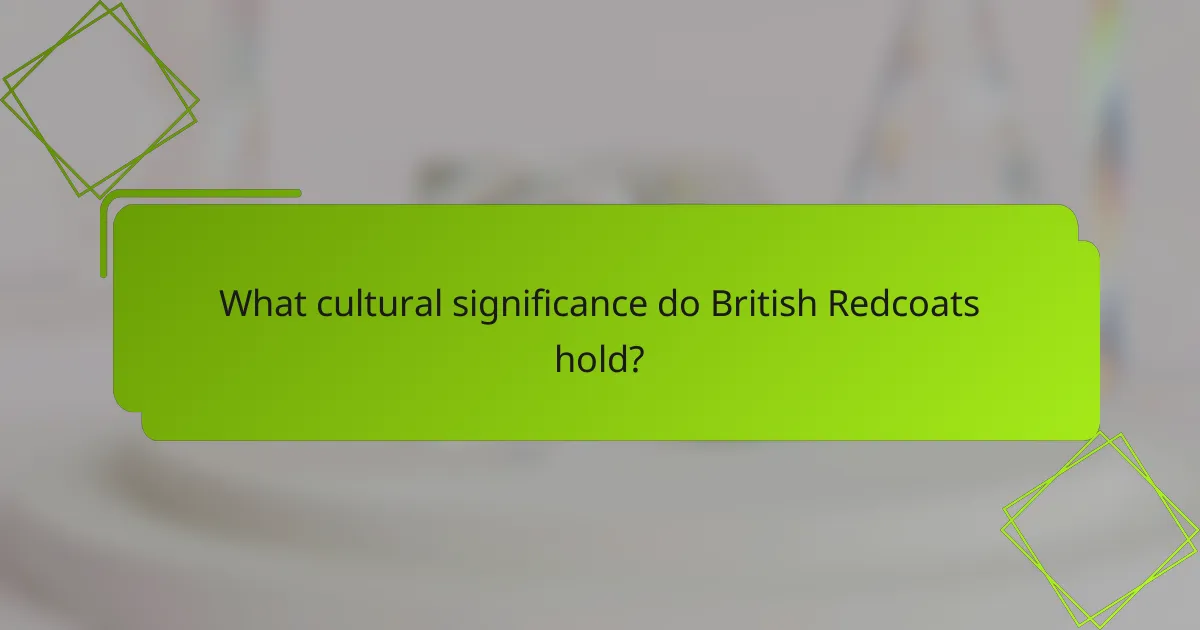
What cultural significance do British Redcoats hold?
British Redcoats symbolize British military history and colonial power. They represent the British Army during the 17th to 19th centuries. The iconic red uniform became a symbol of British identity. Redcoats played a key role in various historical conflicts, including the American Revolutionary War. Their presence often signified British authority in colonial territories. This military attire influenced perceptions of discipline and order. The Redcoat legacy persists in cultural representations, such as films and literature. They are often romanticized as heroes or villains in historical narratives.
How have British Redcoats influenced popular culture?
British Redcoats have significantly influenced popular culture through various forms of media. Their distinctive red uniforms symbolize British military identity. This imagery has been utilized in films, literature, and art. For instance, movies like “The Patriot” depict Redcoats to represent British forces during the American Revolution. Literature often portrays them as antagonists in colonial narratives. Additionally, video games like “Assassin’s Creed III” feature Redcoats as characters, enhancing historical engagement. Their representation has shaped perceptions of British colonialism and military history. Overall, British Redcoats serve as a cultural icon, embodying themes of conflict and national identity.
What representations of British Redcoats appear in literature and media?
British Redcoats are often depicted in literature and media as symbols of British military power. They are portrayed wearing distinctive red uniforms, which signify their role in the British Army. In historical novels, Redcoats are frequently shown in battles during the American Revolutionary War. Films like “The Patriot” illustrate their confrontations with American forces. Additionally, video games such as “Assassin’s Creed III” feature Redcoats as antagonists. These representations emphasize themes of colonialism and conflict. The portrayal of Redcoats often reflects the perspectives of the time, showcasing both heroism and oppression. Overall, British Redcoats are significant cultural figures in various narratives.
How do British Redcoats symbolize British identity?
British Redcoats symbolize British identity through their historical association with the British Army. The distinctive red uniform emerged in the 17th century, becoming a symbol of national pride. Redcoats were prominent during the American Revolutionary War, representing British authority and military power. They embodied the image of a disciplined and formidable force. The uniform’s color and design fostered a sense of unity among soldiers. Additionally, the Redcoats became iconic in British culture, featured in art and literature. Their legacy continues to evoke themes of patriotism and national heritage in modern Britain.
What is the legacy of British Redcoats in modern society?
The legacy of British Redcoats in modern society is reflected in military uniforms and cultural symbolism. Their distinctive red uniforms have influenced contemporary military attire in various nations. The term “Redcoat” has become synonymous with British soldiers, evoking historical imagery. Additionally, British Redcoats are often referenced in literature and films, shaping public perception of the British Army. Historical reenactments preserve their legacy, educating audiences about their role in history. The Redcoat’s image is also used in branding and marketing, symbolizing tradition and resilience. Overall, the British Redcoats have left a lasting mark on military heritage and cultural identity.
How are British Redcoats commemorated in historical reenactments?
British Redcoats are commemorated in historical reenactments through authentic uniforms and drills. Participants wear period-accurate clothing that reflects the styles from the 18th century. These reenactments often include detailed portrayals of military tactics used during battles. Events frequently replicate significant historical battles involving British Redcoats, such as those from the American Revolutionary War.
Reenactors study historical documents to ensure accuracy in their portrayals. They also engage audiences with educational demonstrations about the life of a Redcoat. Many reenactments feature musket firing and formations to showcase military discipline. This approach helps preserve the legacy of the British Redcoats in public memory.
What role do British Redcoats play in contemporary British ceremonies?
British Redcoats serve as ceremonial figures in contemporary British ceremonies. They are primarily featured during events such as Trooping the Colour and state occasions. Their presence symbolizes historical military tradition and national pride. British Redcoats wear traditional uniforms that reflect their historical roots. This attire includes a red coat, white crossbelts, and black boots. The role of Redcoats reinforces the connection to Britain’s military past. Their participation enhances the pageantry of formal events. British Redcoats also contribute to the cultural identity of the United Kingdom.
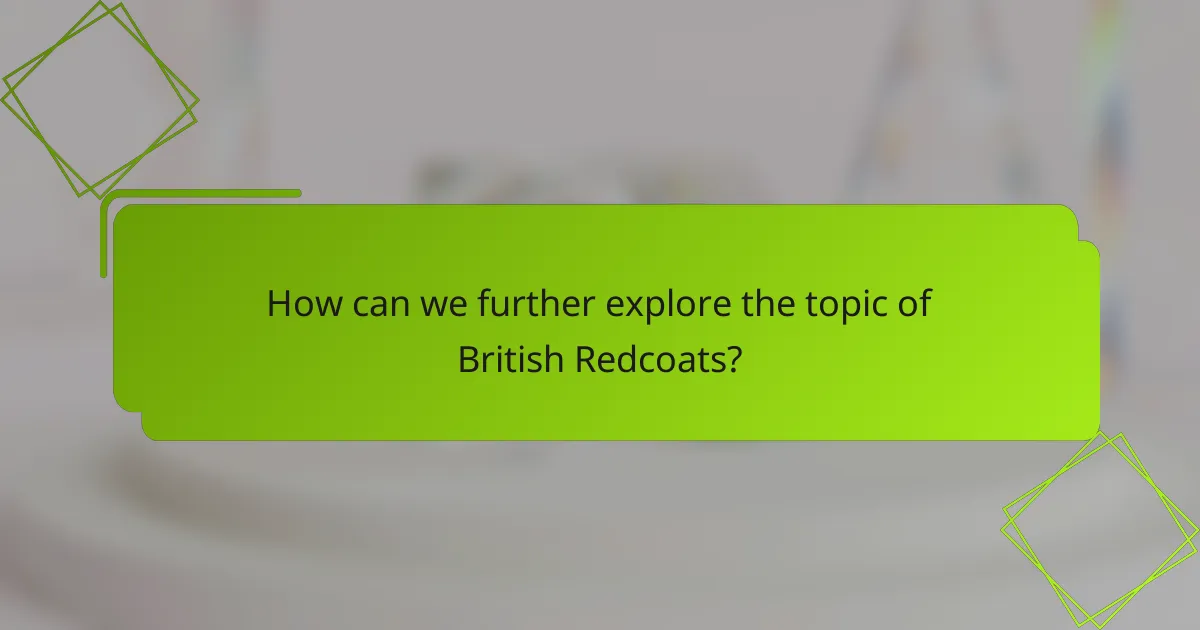
How can we further explore the topic of British Redcoats?
We can further explore the topic of British Redcoats by examining their historical significance. British Redcoats were the soldiers of the British Army, particularly during the 18th and 19th centuries. Their uniform color was a distinctive red, symbolizing British military identity. Researching design changes in their uniforms can reveal adaptations to warfare and climate. Analyzing their role in key battles, such as the American Revolutionary War, provides insight into military strategies. Additionally, studying cultural representations in literature and media can highlight their impact on British identity. Archival documents and military records can serve as primary sources for deeper understanding. Exploring personal accounts from soldiers can also add a human perspective to their experiences.
What resources are available for learning more about British Redcoats?
Books, documentaries, and online resources are available for learning about British Redcoats. Notable books include “The British Soldier: 1750-1815” by Philip Haythornthwaite. This book provides detailed insights into uniforms and campaigns. Documentaries like “The American Revolution” series cover British military history. Online platforms such as JSTOR offer academic articles on British military uniforms. The National Army Museum’s website features exhibits on British Redcoats. Additionally, historical reenactment groups provide firsthand experiences of Redcoat life. These resources collectively offer comprehensive knowledge on the subject.
Which books or documentaries provide in-depth insights into British Redcoats?
“Redcoats: The British Soldier in the American Revolution” by Charles E. Heller offers detailed insights into British Redcoats. This book examines their uniforms, tactics, and experiences during the war. “The British Army: A History” by David Chandler provides a comprehensive overview of the British military, including the Redcoats’ role. “The Redcoat and How to Survive in the 18th Century” is a documentary that explores the life of a British soldier. It includes reenactments and expert interviews. “The American Revolution: A History” by Gordon S. Wood discusses the impact of British Redcoats on American society. These sources collectively provide a thorough understanding of British Redcoats.
How can museums enhance our understanding of British Redcoats?
Museums can enhance our understanding of British Redcoats through exhibitions and educational programs. They display authentic uniforms, weapons, and artifacts from the era. This physical evidence provides context to the historical significance of the British Redcoats. Museums often host guided tours that explain the role of Redcoats in various conflicts. These tours incorporate expert insights and narratives that bring history to life. Interactive displays allow visitors to engage with the material culture of the time. Educational workshops can deepen knowledge about military strategies and daily life of soldiers. Furthermore, museums may collaborate with historians to present accurate and comprehensive information. This multi-faceted approach fosters a deeper appreciation of the British Redcoats’ impact on history.
What are some common misconceptions about British Redcoats?
British Redcoats are often misunderstood in several ways. One common misconception is that all British soldiers wore bright red coats during the American Revolutionary War. In reality, soldiers wore various uniforms, and red was just one of many colors used. Another misconception is that Redcoats were universally disliked by American colonists. While many opposed British rule, there were also loyalists who supported the Redcoats. Additionally, people often believe that Redcoats were poorly trained and unskilled. Historical records show that they underwent rigorous training and were experienced soldiers. Lastly, some think the term “Redcoat” refers only to infantry. However, it originally applied to various branches of the British Army. These misconceptions overlook the complexity of the British military and its historical context.
How can we differentiate fact from fiction regarding British Redcoats?
To differentiate fact from fiction regarding British Redcoats, one must examine historical records and primary sources. Authentic documents include military orders, personal letters, and official reports from the 18th and 19th centuries. These sources provide factual accounts of the role and appearance of British Redcoats in various conflicts.
Additionally, scholarly research, such as “The British Army and the American Revolution” by John W. Fortier, offers insights based on thorough analysis of historical data. This research highlights the actual uniforms, tactics, and experiences of Redcoats, contrasting with popular myths often depicted in media.
Moreover, museum collections and artifacts, such as original uniforms housed in institutions like the National Army Museum, serve as tangible evidence of their historical accuracy. By critically evaluating these resources, one can effectively discern the truths about British Redcoats from exaggerated or fictional narratives.
What are the most frequently asked questions about British Redcoats?
What are the most frequently asked questions about British Redcoats include inquiries about their role in the American Revolutionary War. Many people ask about their uniforms and how they evolved over time. Others are curious about the tactics used by British Redcoats in battle. There are also questions regarding their historical significance and cultural impact. People often wonder about the daily life of a British Redcoat and the challenges they faced. Additionally, questions arise about the training and discipline of these soldiers. The relationship between British Redcoats and local populations during conflicts is another common topic. Lastly, many are interested in the legacy of British Redcoats in modern culture and media.
The main entity of the article is the British Redcoat, a soldier of the British Army known for their distinctive red uniforms. The article explores the evolution of the Redcoat’s design from the 17th to the 19th centuries, detailing key historical events that influenced these changes, such as the American Revolutionary War and the Napoleonic Wars. It also examines the cultural significance of British Redcoats, their representation in popular media, and the legacy they leave in modern society. Additionally, the article addresses common misconceptions and provides resources for further exploration of the topic.
